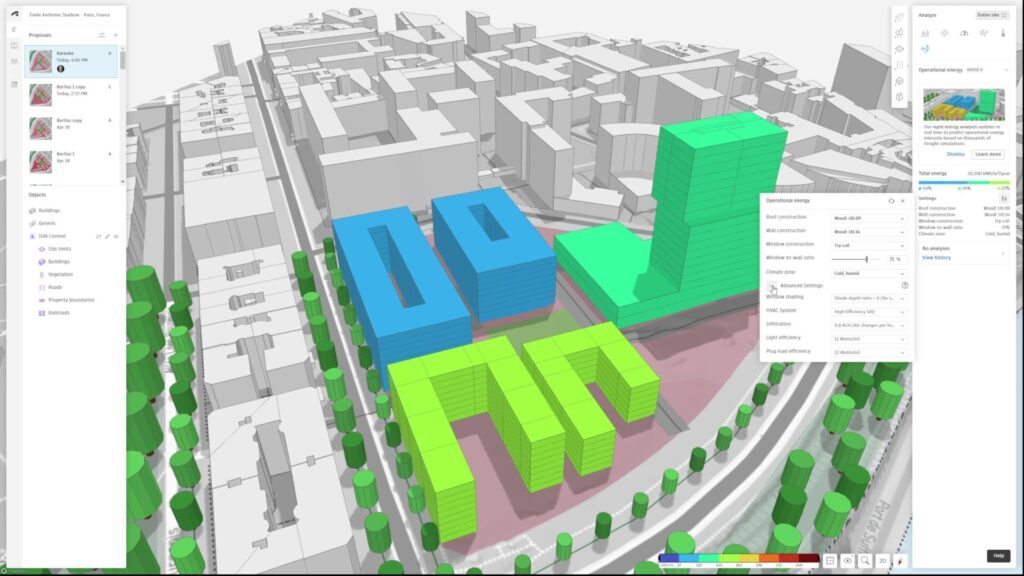
Autodesk Forma’s rapid operational energy analysis forms part of its powerful suite of sustainability solutions created for designers to lower the environmental impact of their buildings. This visual, easy-to-use tool shows predicted operational energy in real time, helping architects and urban planners design with energy efficiency in mind.
The analysis allows designers to easily assess the impact of design decisions on the potential operational energy of their buildings during early-phase design. It forms part of Forma’s real-time analyses including microclimate, solar panel, sun hours, daylight potential, wind, views and noise, which equip design teams with the insights needed to improve sustainable outcomes.
Any built structure has associated carbon emissions, in both the building materials and construction process – embodied carbon – and while the building is in use – operational carbon. Operational carbon is the metric for measuring carbon emissions generated when occupied buildings consume energy for heating, ventilation, and air conditioning (HVAC), lighting, and appliances – known as operational energy. Buildings are responsible for 40% of global energy consumption and produce one third of the world’s greenhouse gas emissions. Therefore, understanding, measuring, and addressing operational energy in the early stages of design can make a big difference on our collective environmental impact.
Håvard Haukeland, Senior Director at Autodesk: “Sustainability is the top of everyone’s agenda, and being able to prioritize energy efficiency from the start of the design process, where the biggest positive impact can be made, is key. Our new operational energy tool means architects can easily simulate optimal solutions from day one to find the right strategies to reduce energy usage.”
The analysis has already been tested by influential design practices. Pablo La Roche, Principal and Performance-Driven Design Lead at CallisonRTKL comments: “At CRTKL, we believe sustainable design is a necessity, not an option. Forma’s new operational energy analysis tool makes this easier as it allows our designers to better understand the implications of their design decisions at the onset of projects. Tools like this help make sustainable design more accessible and enable us to further CRTKL’s vision of People, Planet, Positive Design.”
How does it work?
In the analysis, users can modify a selection of key design factors for energy consumption – including geometry, window-to-wall ratio, and roof and wall construction types – while iterating their building masses and then immediately see how those interrelated factors impact predicted energy use (kWh/m2/year). This instant feedback during design allows users to make iterations faster while visualizing the energy impacts of their decisions. After formulating an initial strategy in Forma using rapid operational energy analysis, users can further refine their design in Autodesk Revit and Insight.

Typically, building energy analysis tools are used in the detailed design phases when fundamental decisions, such as massing, orientation, and envelope design, have already been determined. In detailed design, it can be difficult and costly to make major changes to those early decisions that would improve energy efficiency, so the focus often turns to secondary measures such as insulation thickness, window shading and HVAC system efficiencies. While many factors affect energy usage, these early design decisions, often made before engineers and energy consultants are engaged in a project, can be the biggest energy drivers. Forma’s new analysis enables users to optimize operational energy performance and building efficiency when it’s most cost- and time-effective.
At the same time, existing energy analysis tools can be complex and technical, requiring detailed design– and operational inputs and expert understanding of the data. Forma leverages the same complex analysis, integrating into the massing model in an intuitive interface. The analysis uses machine learning, whereby a huge dataset of building models was first analyzed with a complex energy simulation engine for energy usage against a variety of building factors. These results were used to train a machine learning model that predicts energy use and enables this rapid analysis for early, quick and accurate results.
Rapid operational energy analysis joins Forma’s suite of predictive analyses which includes noise and wind. Technical information about the analysis and the machine learning model are available in this Help Center article.
Håvard Haukeland concludes: “Data-driven tools – like the rapid operational energy analysis – provide the foresight designers need to avoid potential design and construction issues at later stages, saving on time and costs across the entire process. This analysis is a major step in helping designers create efficient, long-lasting, and most importantly, sustainable buildings.”